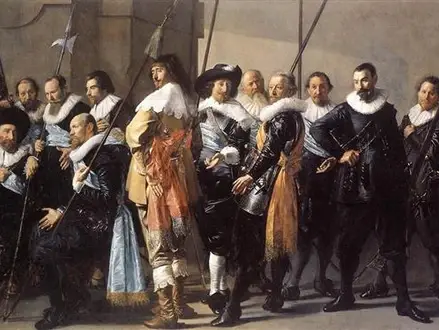Title of Artwork: “Meagre Company”

Artwork by Frans Hals
Year Created 1633-1637
Summary of Meagre Company
The phenomena of the military group picture has its roots in early 16th-century Dutch art. While he was alive, Frans Hals painted a number of military portraits, one of the most well-known of which being The Company of Captain Reinier Reael and Lieutenant Cornelis Michielsz Blaeuw (1633-1637).
All About Meagre Company
As a result of the commanders’ slender stature, The Meagre Company has been nicknamed. In 1633, Hals obtained a commission from the St. George Civic Guard of Amsterdam to paint a military group photograph. In 1637, Amsterdam painter Pieter Codde completed the picture after Hals and the commanders disagreed over its final details. Hals’s creative process is illuminated by the ensuing squabble, which was documented in a series of letters.
He began working from left to right after establishing the composition. There are multiple journeys to Amsterdam in Hals’ correspondence. It was still difficult to get all of the officers together for a sitting, which delayed his completion of the painting.
In the end, Hals proposed that the officials come to Haarlem for a sitting, but Reael and Blaeuw refused, and in turn, asked that the task be completed promptly in Amsterdam. That’s why Hals and the sitters eventually split up, but the conversation makes it crystal obvious that Hals need their attendance throughout the entire process of creating the piece.’
Initially, Hals needed the entire group to put together the composition, and later, he needed time with each sitter to produce the individual portraits.
For Hals’ composition, he used three different planes to arrange the sixteen figures. The slanted location of the armament countered the strong vertical balance created by the upright men. Hals’ The Officers of St. Adrian Militia Company mimics the composition of the cluster on the left side of the picture (1633).
Drama and dynamics were created in Hals’ composition by using several positions. Silk sashes, elaborate lace collars, chamois boots, and metal armors were just a few of the artist’s creations that showcased his mastery of texture and material.
Each strand of his hair and moustache was treated with the same level of care and attention. Adding to the originality of each character and infusing the painting with vibrancy is the variety of hair and face haircuts used.
It was more than two centuries later that Vincent van Gogh witnessed the expertise of Hals during his visit to Amsterdam. When Van Gogh wrote to his brother Theo about Hal’s colour sense, he gushed about how many shades of black he could distinguish. Attracted by both the flag bearer on the far left and Hals’s ability to manufacture a range of materials out of the same pearl-grey tint, Van Gogh spent considerable time with The Meagre Company.
These abilities are linked to the painting’s dazzling, silvery light that fills the space. Objects such as spectacles, brocades, silks, and metal armour and weaponry all catch the light and appear to sparkle and shine. Hendrick Terbrugghen, an Utrecht Caravaggisti painter, may have inspired Hal’s silver tonality in his picture.
Information Citations
En.wikipedia.org, https://en.wikipedia.org/.
























